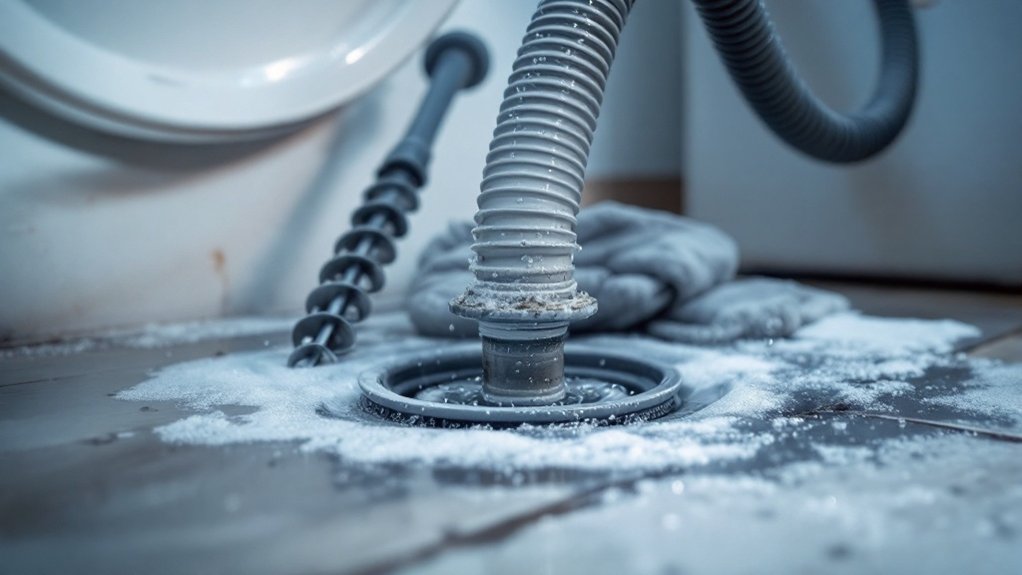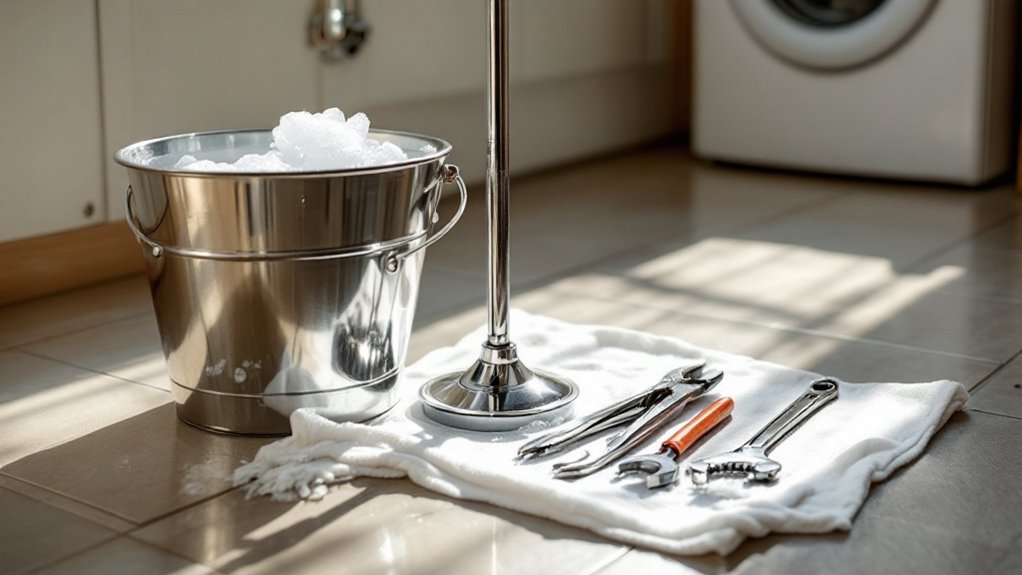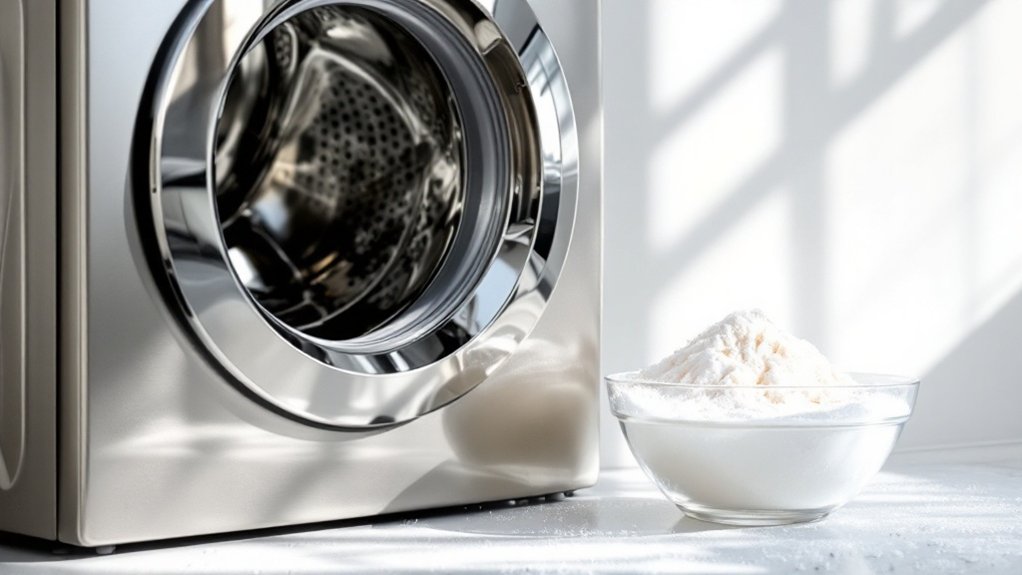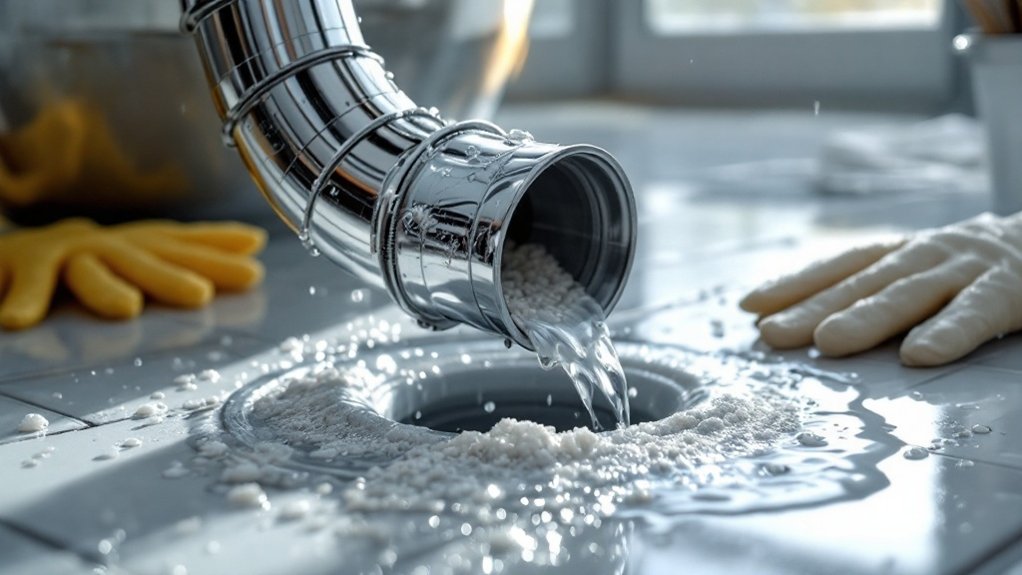To unclog your washing machine drain pipe, first check for standing water or unusual odors indicating a blockage. Try pouring a mixture of baking soda and vinegar down the drain, followed by hot water after 30 minutes. For stubborn clogs, use a drain snake to manually break up obstructions. Clean the drain pump filter monthly and avoid overloading your machine. Regular maintenance with these simple techniques will spare you future drainage headaches and costly repairs.
Key Takeaways
- Pour baking soda and vinegar into the drain, wait 30 minutes, then flush with hot water to break down clogs.
- Clean the drain pump filter monthly by accessing it from the front panel and removing any debris.
- Use a drain snake or handheld auger to physically break up stubborn blockages in the drainage pipe.
- Run an empty hot water cycle with vinegar regularly to prevent soap scum and lint buildup.
- Check for and remove kinks in the drainage hose, ensuring it’s properly positioned without sharp bends.
Identifying Signs of a Clogged Washing Machine Drain

Vigilance is key when monitoring your washing machine’s drainage system. Several clogged indicators warrant immediate attention: standing water after cycles, gurgling sounds from pipes, and persistent foul odors emanating from the drain.
You’ll notice practical drainage consequences in your laundry routine. Clothes remain excessively wet after the spin cycle completes. Your machine may produce unusual vibrations or loud noises during operation, particularly when spinning. These symptoms indicate the pump is struggling against an obstruction.
Early identification prevents energy waste, water damage, and potential mechanical strain that could lead to costly repairs. Additionally, stormwater management solutions can help address broader drainage issues that may affect your home.
Essential Tools and Materials for Unclogging Drains

To effectively unclog your washing machine‘s drainage pipe, you’ll need both chemical solutions like vinegar-baking soda mixtures or commercial drain cleaners, and mechanical tools such as drain snakes or augers for stubborn blockages.
Proper protective equipment including gloves and safety goggles is essential when handling drainage systems or chemical products.
Regular maintenance supplies, including a screwdriver for accessing the filter and clean towels for spill management, will help prevent future clogs and protect your workspace during the unclogging process.
Basic Chemical Solutions
When facing a clogged washing machine drain, several chemical solutions offer effective first-line remedies before resorting to mechanical methods.
The baking soda-vinegar combination creates powerful chemical reactions that safely break down clogs while remaining eco-friendly. Pour hot water first, followed by one cup each of baking soda and vinegar, then let sit for 30 minutes.
For tougher blockages, commercial cleaners provide stronger solutions—enzyme-based products offer gentler alternatives to harsh corrosives. Always wear protective gloves and eyewear when handling chemicals.
Regular hot water flushing helps prevent buildups, while household sodas offer minimal effectiveness through their mild acidic properties.
Mechanical Unclogging Tools
While chemical solutions address many washing machine clogs, mechanical methods provide reliable alternatives when substances alone can’t clear stubborn blockages.
For effective mechanical unclogging, you’ll need specialized tools. Handheld Augers, particularly drum augers, excel at maneuvering through the small-diameter traps in laundry drains and removing hair buildup.
Manual drain snakes can break up obstructions by reaching deep into pipes. Bladder Openers create pressure inside the drain to force clogs outward, particularly useful for washing machine lines.
Always wear protective gloves and eye protection when using these tools. For persistent blockages, consider advanced options like hydro-jets or motorized drain snakes that provide additional power.
Preventative Maintenance Supplies
Maintaining a properly functioning washing machine drainage system requires five essential preventative maintenance supplies that every homeowner should keep on hand. Properly installed drain pans provide critical floor protection, while regular lint trap maintenance prevents costly clogs.
| Supply | Function | Maintenance Frequency |
|---|---|---|
| Drain Pans | Protect floors from leaks | Check monthly for cracks |
| Lint Traps | Prevent drain clogs | Clean every 2-4 loads |
| Baking Soda/Vinegar | Natural cleaning solution | Apply quarterly |
Use a 1:1 ratio of baking soda and vinegar for environmentally friendly maintenance. Document your cleaning schedule to guarantee consistent upkeep and extend your drainage system’s lifespan.
The Baking Soda and Vinegar Method

For those facing a sluggish or completely blocked washing machine drain, the baking soda and vinegar method offers a simple yet effective solution.
The process leverages a chemical reaction between alkaline baking soda and acidic vinegar to generate carbon dioxide bubbles that dislodge debris.
Start by pouring a cup of baking soda directly into the drain, followed immediately by one cup of white vinegar.
Cover with a rubber stopper and allow 10-15 minutes for the vinegar reaction to work.
You’ll hear fizzing as the mixture attacks the clog.
Finish by flushing with boiling water to clear residue.
Using Hot Water Treatments Effectively
Hot water treatments represent one of the simplest yet surprisingly effective methods for clearing minor clogs in washing machine drainage pipes. This technique dissolves soap scum and detergent buildup that commonly restrict water flow.
For minor washing machine clogs, hot water treatments effectively dissolve soap scum and detergent buildup that restrict drainage flow.
To implement this method properly:
- Unplug your machine and detach the drain hose from the drainpipe
- Pour at least 1 gallon of hot (not boiling) water directly into the pipe
- Allow water to work gradually through the system
- Reattach and test drainage function
Incorporate hot water flushes into your regular maintenance schedule every few months to prevent future blockages, extending both your machine’s lifespan and plumbing system’s efficiency.
How to Use a Plumber’s Snake for Stubborn Clogs
To properly insert a plumber’s snake into your washing machine drainage pipe, lock the cable and rotate the drum clockwise while feeding the flexible coil into the drain.
You’ll need to release the cable periodically to extend it further as you navigate through bends and curves in the piping.
When you feel resistance indicating the blockage, secure the drum’s lock mechanism and rotate forcefully to break through the clog, then extract the snake with the debris attached.
Snake Insertion Technique
A plumber’s snake offers the most effective solution for tackling stubborn clogs that resist conventional methods.
Begin by feeding the snake cable into your washing machine drain pipe until you feel resistance, indicating the clog location. Lock the cable in place before attempting to navigate further.
- Maintain proper snake depth by extending in short increments
- Apply controlled cable rotation to snag the clog without twisting
- Navigate P-traps carefully by locking and rotating as needed
- Keep track of the cable’s path to prevent tangling
Remember to wear protective gloves during this process to safely manipulate the snake through your drainage system.
Breaking Through Blockages
When you encounter a stubborn blockage that resists your initial efforts, proper technique with your plumber’s snake becomes essential for success. Rotate the snake clockwise while applying gentle pressure—this engages the corkscrew tip to break through or grab the clog for extraction.
| Action | Purpose | Safety Note |
|---|---|---|
| Rotate clockwise | Engages corkscrew tip | Prevents snake kinking |
| Apply steady pressure | Penetrates blockage | Avoids pipe damage |
| Pull back slowly | Extracts clog material | Contains debris |
| Repeat if necessary | Guarantees complete removal | Prevents recurrence |
| Flush with hot water | Clears remaining residue | Confirms drain cleaning success |
Unlike chemical solutions, mechanical drain cleaning physically removes the entire blockage while maintaining plumbing safety.
When to Call a Professional Plumber
Despite your best efforts to resolve drainage issues, some washing machine clogs require professional expertise.
When to call a professional plumber depends on specific indicators that suggest complexity beyond DIY solutions.
- Multiple drain clogs occurring simultaneously, indicating a deeper sewer line issue
- Persistent drainage problems after attempting standard unclogging methods
- Unusual odors emanating from drains despite thorough cleaning
- Water backing up into other fixtures when the washing machine drains
These situations typically require specialized equipment like drain cameras or hydro-jetting to diagnose and resolve effectively.
Addressing these issues promptly prevents potential water damage, mold growth, and more extensive plumbing failures.
Preventing Future Drainage Issues
Maintaining your washing machine’s drainage system proactively prevents costly repairs and inconvenient breakdowns. Implement these preventive strategies to guarantee peak drainage performance.
| Preventive Measure | Implementation Method | Frequency |
|---|---|---|
| Filter Cleaning | Remove and rinse drain pump filter | Monthly |
| Drain Guards | Install mesh guards to catch debris | Replace quarterly |
| Eco-friendly Cleaners | Pour 1 cup of vinegar and baking soda solution | Bi-monthly |
Guarantee proper hose installation without kinks or bends that restrict flow. Balance loads to prevent excess lint accumulation. Regularly inspect drainage pipes for adequate slope, which facilitates proper water flow. Professional system testing annually can identify potential issues before they escalate.




